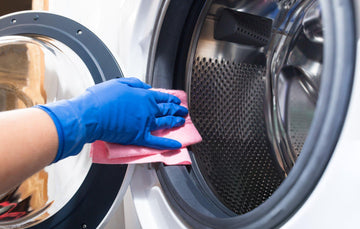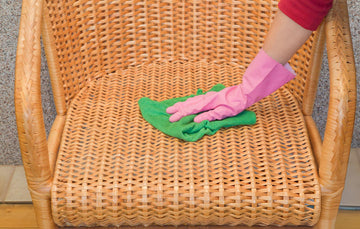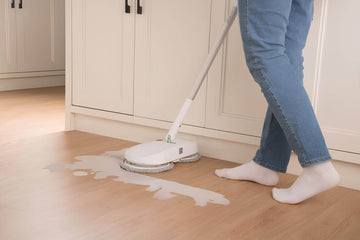Are your whites coming out gray and your darks looking dull? These are signs that your washing machine needs thorough cleaning. Over time, soap scum, dirt, and bacteria build up, creating odors and reducing your washer's efficiency.
Now, here is the best part. Giving your washing machine a deep clean is simpler than you might think. With a few easy-to-follow steps, you can make your washer squeaky clean and get cleaner, brighter laundry. So, ready to learn the secrets to an odorless and spotless laundry machine?
Let's get the steps to get your washer back to peak condition.
Signs Your Washing Machine Needs Cleaning
A few common signs can reveal that your washer needs a thorough cleaning.
Black Residue and Mold Buildup
Your washer's door seal may have black residue or mold if you take a closer look. This unsightly buildup is due to the accumulation of the detergent, moisture, and dirt over time. Mold not only smells bad but can even rub off on your clothes and potentially cause discoloration and itchiness. To prevent this, regularly wiping the seal and using a washer cleaner can prevent this issue. You may learn more about mold cleanup and prevention from the EPA Mold Cleanup Guide.

Stubborn Detergent Marks
The long streaks of detergent on garments or residue in the dispenser drawer means the washer isn't rinsing well enough. This could be due to the lack of water supply, or jammed dispensers. These marks not only look unpleasant but also reduce the softness and freshness of the fabric. It is helpful to clean the dispenser drawer and use the right dosage of detergent to prevent this hassle.
Limescale Deposits Inside the Drum
Chalky white deposits inside the drum and on the heating elements are the signals of limescale buildup. This is usual especially in regions with hard water. Limescale affects the efficiency of your washer, which leads to more energy consumption and poor cleaning. Descaling detergents that are meant especially for washing machines can effectively remove such deposits and thus prolong the life of your washer.
Clothes Emerging Still Dirty
If your clothes are not getting cleaned, there may just be problems with your blocked filters, clogged pipes or improper draining. Such issues make your washer recycle dirty water instead of draining it, leaving dirt and stains on clothes. Regularly checking and cleaning filters ensures your washer operates effectively and prevents such mishaps.
Strange and Unusual Noises
Any strange thumping, grinding or shaking during the wash cycle are not mere nuisances. In most cases they are signs of blockages, worn bearings or loose parts. Failure to eliminate these problems leads to more damage, resulting in expensive repairs. Scheduled cleaning and maintenance can save you significant time and money.
Now comes the cleaning process but the cleaning process can't begin until you urgently equip yourself with the right tools. Check out the right tools you need to carry out the clean-up:
What You'll Need to Clean Your Washing Machine?
Cleaning the laundry machine is simple and easy. A regular cleaning kit can do the job. You would only need a small microfibre cloth with an old toothbrush to do the wonders. Additionally, a dish or container to hold liquid cleaner will help. There are a multitude of liquid cleaner options. Choose liquid chlorine bleach, hydrogen peroxide, or distilled white vinegar.
Moreover, commercial laundry machine cleaners are also available. If not, you can go with an all-purpose cleaner and baking soda.
All-Washing-Machine Cleaning Guide
Do you want to clean the inside of the washing machine effectively? Here's a step-by-step you need. Follow the steps to clean any type of washing machine.
Clean the Interior with a Vinegar Hot Wash
Select the longest cycle on the washer dial and set the highest temperature. Let it fill with water while keeping the top load size. Run the machine and add 4 cups of white vinegar, keep the machine running for at least five minutes. Don't drain the water for about 30-60 minutes to extract grime and grease.
Thoroughly Clean the Drum and Interior
Next, drain the water completely. Use a microfiber cloth to clean the interior and wipe out excess water. Any grime or soap deposits should be scrapped with a toothbrush. Check the corners and rotatory part of the drum. Make sure to clean the detergent dispenser.

Wipe Down and Polish the Machine Exterior
Did you clean the washing machine's interior? Now, get a soft cloth to shine up the exterior. The soap stains are quite stubborn. A citrus cleaner will be helpful in getting rid of them. Use the toothbrush to reach congested parts.
Run a Follow-Up Hot Cycle
Recheck the laundry machine interior. If any greasy buildups are remaining, redo the vinegar hot wash. Add baking soda to ensure proper cleaning. Then a follow-up hot cycle clears grease and grim. The vinegar dissolves soap residue, while bleach kills bacteria and eliminates mold.
Top-Loading Washing Machine Cleaning
Cleaning the top-load laundry machine is easy and seamless. Run the machine and fill the washer drum with water. Follow these three simple steps for deep cleaning:
Pause the Cycle and Use Vinegar to Soak
Add vinegar to the washer drum while the machine is running. The recommended measurement for a top-load washing machine is 945ml (3 cups approx.). Ensure the water temperature is set to the highest level. Pause the cycle and let it rest for an hour.
Reach and Clean the Hidden Spots
Drain the water when you notice the grease and grime appear at the surface. Take a microfiber cloth to wipe out the water. Use a toothbrush to reach the corners and edges. Usually, the soap residue and mold deposits accumulate in the corners.
Polish the Exterior for a Spotless Finish
The exterior often has soap stains and hard water blemishes, similar to those commonly found when cleaning bathroom floor. Apply an all-purpose cleaner around the washing machine and polish the exterior with a soft cloth. Use vinegar if the stains are particularly stubborn.
Front-Loading Washing Machine Cleaning
The cleaning process does not change for the front-load washing machine. You need to add the vinegar to the detergent compartment and repeat the same steps. Throw baking soda into the tub for a deep cleaning. Don't miss out on the following considerations:
Give the Rubber Gasket a Thorough Scrub
Most of the time, water deposits are made at the rubber gasket of the front-load washing machine. It leads to stains and a buildup of soap residue. A scrub is helpful in cleaning the rubber gasket. Use warm water, and don't be tough. Otherwise, the seal can be damaged.
Remove Mold and Mildew for a Fresher Machine
Mold and mildew form in different parts of the washing machine. The detergent compartment is a breeding hub for mold and mildew. Thoroughly check the machine for any signs. Spray vinegar and chlorine bleach to eliminate mold and mildew. Use a scrub or cloth to wipe it out.
Why Does Your Washing Machine Smell, and How To Fix It?
Funky smells can build up over time into e washing machines. Dirt, soap scum, and debris collect in seals, nooks, and crannies. This creates a perfect environment for mildew, bacteria, and mold to form. Front-loading machines are especially prone to this issue where door gasket is a breeding ground for icky smells.
To combat the stink, use the right detergent for your machine. Don't add too much— excess soap leaves a residue. This attracts more dirt and amplifies bacteria growth. Leave the machine door open for a few hours after each load. This helps excessive moisture evaporate. You can also run a cleaning cycle or a hot water cycle with a washing machine cleaner every 1-2 months to keep your machine fresh. If odors persist, consider using enzyme-based cleaners designed to break down organic buildup.
Common Mistakes to Avoid When Cleaning Your Washing Machine
Some common mistakes can make cleaning worse. Learn more to avoid them:
Skipping Pre-Cleaning Inspections
Many ignore inspecting the machine before cleaning. Check for loose wires, cracked seals, or debris in the drum. Fix these issues to avoid further damage during cleaning.
Using Vinegar Frequently
Vinegar, though natural, can corrode rubber parts if used too often. Limit its use to occasional deep cleaning and replace it with a machine-safe cleaner for regular maintenance.
Not Checking the Discharge Hose
Clogged or kinked hoses lead to poor drainage. Detach the discharge hose quarterly, flush it with water, and ensure it's securely reconnected.
Overlooking Load Sensor Calibration
Some advanced machines have load sensors. Cleaning mishandles them if you don't recalibrate post-cleaning. Refer to the manual for proper settings.
How Often Do Washing Machines Need Cleaning?
Families doing laundry frequently should clean their washing machines at least once a month to keep clothes fresh and free from odors. For singles or smaller households, cleaning every two to three months is sufficient.
High-efficiency washers, which use less water, can accumulate detergent and fabric softener residue faster. This means they need more frequent cleaning. A good rule of thumb is to clean the machine after 40 loads of laundry to prevent buildup and keep it running efficiently.
Innovative Self-Cleaning Modern Washing Machines
Self-cleaning is an advanced feature in modern laundry washers. The washing machine cleans itself once you run the function. Primarily, the machine uses detergent and hot water for cleansing. The washer flushes the water mix in the drum, dispenser, and through hoses.
The self-cleaning doesn't mean that you don't need to clean the washing machine. It only enhances the cleaning process. Performance also improves with self-cleaning mode. The drains usually don't get clogged. However, you should deep clean the washing machine from time to time.
Clean Every Mess with Yocada's Innovative Cleaning Products
Yocada is an expert in home cleaning tools, we offer a comprehensive range of innovative cleaning tools. Each product is carefully crafted to make home cleaning easier for your family with sophisticated designs and eco-friendly materials. Discover effective bathroom and laundry cleaning supplies, make cleaning easy with Yocada's innovative cleaning products!
Final Thoughts
You'd be surprised how much better your washing machine works when it's clean! It only takes a little effort, but it really pays off by preventing odors and grime buildup. Make washing machine cleaning a habit, and you'll keep your laundry smelling fresh and your washer working like new!




